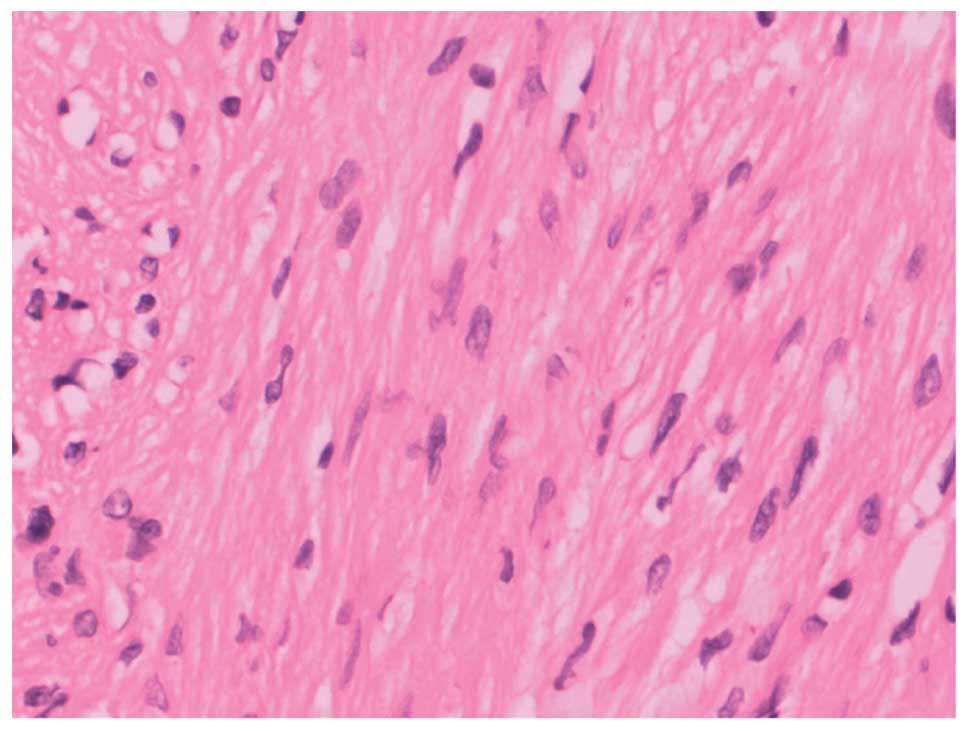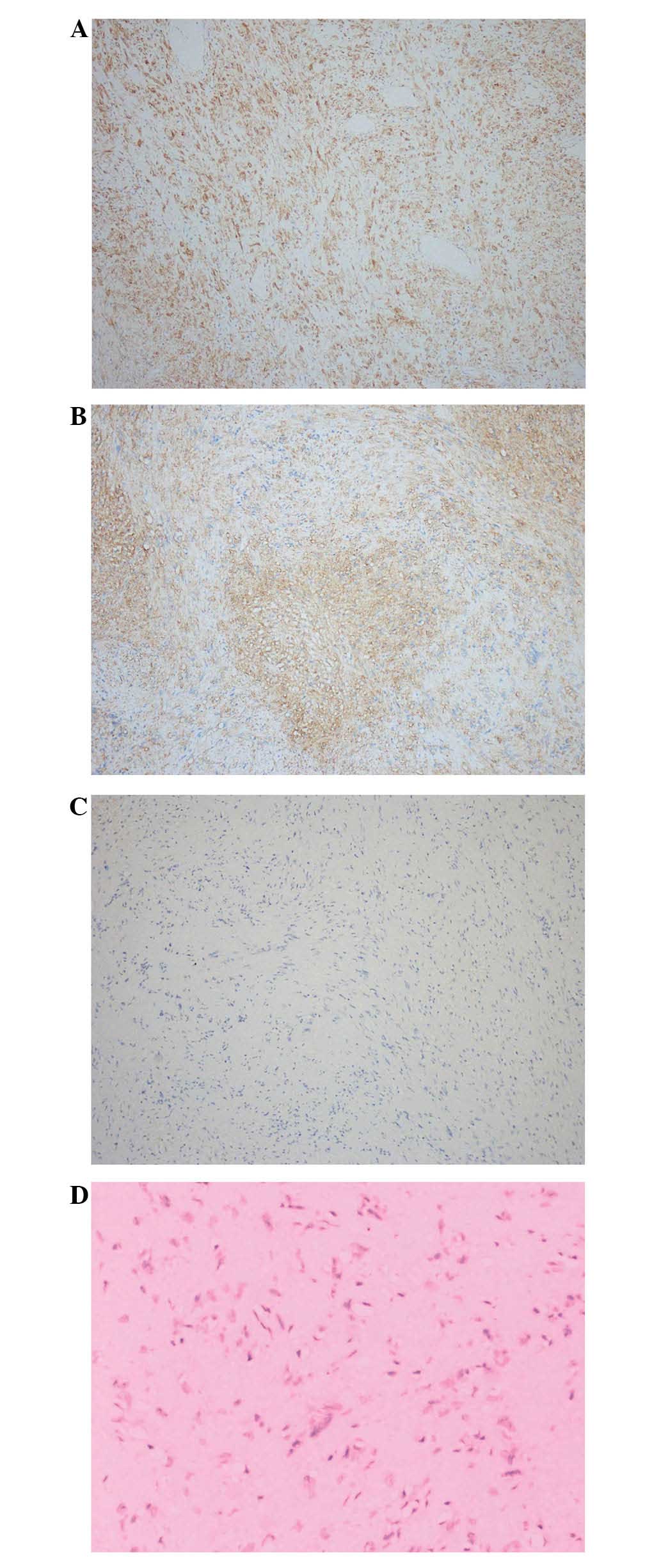Olfactory ensheathing cell tumor: A case report and review of the literature
- Authors:
- Published online on: March 16, 2015 https://doi.org/10.3892/ol.2015.3042
- Pages: 2078-2084
-
Copyright: © Mu et al. This is an open access article distributed under the terms of Creative Commons Attribution License.
Abstract
Introduction
Olfactory ensheathing cell tumors (OECTs) are rare malignancies of the anterior fossa that share similar clinical and radiological features with olfactory groove schwannomas (OGS) (1). Forming a pre-operative diagnosis is challenging due to these similarities, which include anosmia. It is also necessary to differentiate these malignancies from common meningiomas in the anterior fossa (2). OECT was first identified as a distinct entity by Yasuda et al in 2006 (1), and only seven cases have been reported to date (1,3–8). Therefore, little information is available with regard to the clinical, radiological and immunohistochemical characteristics of OECTs (5). The current study presents the first reported case of OECT in China, which occurred in a 20-year-old male. In addition, the seven known cases are reviewed, with a summary of the clinical manifestations, imaging characteristics, intraoperative findings and immunohistochemical features of OECTs. This provides important clinical information for the pre-operative diagnosis and intraoperative removal of OECTs.
Case report
A 20-year-old male was admitted to The First Hospital of Jilin University (Changchun, Jilin, China), after presenting with a severe headache lasting for one day and a generalized convulsion, during which the patient lost consciousness for 30 min. The medical history included intermittent headaches for four years, which had been treated with painkillers as required. Upon examination, no neurological deficits were identified. Olfactory function was normal and no stigmata of neurofibromatosis were observed.
Cranial magnetic resonance imaging (MRI) revealed a round, patchy mass of 3.4×2.6×5.0 cm in the left anterior fossa, with long T1 and T2 signals. The lesion was hypointense on the fluid-attenuated inversion recovery sequence. Heterogeneous enhancement and necrosis of the tumor were observed following intravenous gadolinium injection (Fig. 1). Abnormal long T1 and T2 signals were observed in the tumor-adjacent tissues without enhancement. The lateral ventricles and third ventricle were enlarged with a right and posterior shift of the midline. Abnormal long T2 signals were observed in the thickened mucosa of the bilateral ethmoidal sinuses. The diagnosis was of an occupying lesion (possible meningioma) in the left anterior fossa.
The patient was placed under general anesthesia and a left frontal craniotomy was performed via a coronal incision. The tumor was located on the base of the left anterior fossa, posteriorly extending into the anterior clinoid process. The tumor was slightly adherent to the dura mater of the anterior fossa, and was surrounded by the arachnoid membrane. The tumor had grown toward the left olfactory groove and compressed the left frontal cortex. The tumor presented with a greyish-red appearance, cystic necrosis and a rich blood supply, with a rubbery encapsulation creating a distinct boundary from the surrounding brain tissue. The tumor was debulked and completely removed, as confirmed by a post-operative computed tomography (CT) scan. The left olfactory bulb and nerve tract were not observed during the surgery.
Post-operative hematoxylin and eosin (HE)-stained sections revealed that the tumor was composed of spindle-shaped cells, predominantly arranged in compact fascicles or fibrous cords, with a few cells arranged in whorls. The matrix contained bundles of mature collagen fibers parallel to the cells (Fig. 2). Immunohistochemical staining revealed that the tumor was immunopositive for vimentin and S-100, and immunonegative for epithelial membrane antigen and Leu-7 (Fig. 3), leading to a final diagnosis of OECT.
The post-operative course was uneventful, and the patient was discharged two weeks after surgery, without headache but with left-sided anosmia. The patient was in relatively good health during the two-month follow-up examination, despite persistent left-sided anosmia. A cranial MRI revealed no recurrence of the tumor.
Discussion
OECT was first identified as a being distinct from schwannoma based on its Leu-7 immunoreactivity (1). The current study is the eighth reported case of OECT. Table I summarizes the clinical manifestations, imaging characteristics, intraoperative findings and immunohistochemical features of all reported cases. There appears to be no gender difference amongst the eight OECT cases, with four male and four female patients affected. The patient in the present case is the youngest from the reported cases, and the average age of the OECT patients is 34.1 years (range, 20–49 years). This is younger than that of patients with schwannomas (9).
As OECTs are located in the anterior fossa close to the olfactory nerve, olfactory dysfunction is a common clinical manifestation (1,3–8). Five of the seven cases reported in the literature presented with anosmia, including two cases with right-sided anosmia, two cases with bilateral anosmia and one case with hyposmia. However, the current patient, along with two additional cases, had normal olfaction, suggesting that olfactory dysfunction is not a necessary indicator for OECT patients. In addition, seizures occurred in four cases, including one case with a generalized convulsion (1), one case with multiple episodes of generalized tonic clonic seizures (3), one case with seizure attacks for six months (4), and one case with complex partial seizures for 18 months (5). In the present case, the patient experienced a severe headache with a generalized convulsion, and also presented with a history of intermittent headaches over four years, which may have been associated with increased intracranial pressure. Furthermore, emotional lability with complex partial seizures occurred in one patient (6), and visual impairment occurred in another case (8). No cutaneous stigmata of neurofibromatosis were observed in any of the cases, however, five cases, including the present case, reported skin conditions.
All patients in the eight reported cases underwent CT and/or MRI scans. Of the six patients for whom CT scans were conducted, a tumor with calcified nodules was observed in one patient (1), and homogenous enhancement was found in another (3). In addition, tumor invasion to the skull base and ethmoid bone was reported in four cases. In certain cases, tumor erosion of the cribriform plates or skull base was clearly visualized by three-dimensional (6) and bone window coronal (5) CT scans. Therefore, these types of CT scan are strongly recommended due to their ability to identify tumor invasion, and thus are useful for distinguishing OECT from meningioma. One study reported that the tumor appeared as an avascular structure on angiography (1). Tumors with cystic changes were described in two cases (7,8), and strong post-gadolinium contrast enhancement in the solid portions of the tumor was reported in one case (7). Two cases reported that there was no edema in the tissues surrounding the tumor (1,5), possibly due to the encapsulation and expansive growth of the tumors. The large diameter of the masses, ranging from 3.9 to 6.5 cm, is likely due to the large space available in the anterior fossa, and the prolonged growth period promoted by minimal intracranial pressure symptoms. Heterogeneous enhancement of the tumor on MRI following intravenous contrast administration was reported in six cases, and no dural tail signs were observed in any of the eight cases. Tumor necrosis was visible on enhanced MRI in the present case. Enhanced MRI may therefore be useful for distinguishing OECTs from meningiomas in the anterior fossa, which commonly display homogeneous enhancement without any signs of necrosis (2). However, radiological imaging may be unable to distinguish OECT from OGS.
To date, the only method that allows the distinction of OECT from OGS is immunohistochemical staining: OECTs are immunonegative for Leu-7 and epithelial membrane antigen, and immunopositive for S-100, while OGSs are immunoreactive for Leu-7 (1). Other pathological characteristics of OECTs include the arrangement of spindle-shaped cells in fascicles, fibrous cords or whorls, with distorted nuclei arranged in a palisading pattern, as observed by HE staining. In the cases described, only one reported that the tumor had indications of a previous hemorrhage with hemosiderin deposits (4). Two cases reported electron microscopic findings, in which amoeba-like cytoplasmic processes with abundant collagen fibers around the cells were observed (1,4).
Since OECTs are located in the midline or extra-axial spaces, the majority of the tumors (7/8) were excised via unilateral or bilateral frontal craniotomies, with a subtotal incision performed via an endoscopic endonasal approach in one case (7). The tumors were described as greyish-white (4,5), firm (5) or cystic (7), with less blood loss during surgery compared with OGS. However, the tumor in the present case was greyish-red with a rich blood supply and cystic necrosis. Tumor invasion into the olfactory groove, cranial base, internal orbital wall or cribriform plate was reported in four cases (1,5–7), and the bone or dura mater defects were repaired using a temporalis flap and fibrin glue, or mucoperiosteal pedicle flaps (5,6). Similar to two of the reported cases (1,4), in the present case, the olfactory bulb and tract (left side) were not observed. In addition, the current patient exhibited no tumor recurrence at the two-month follow-up examination. Likewise, no tumor recurrences were reported in the previous cases, with a mean follow-up period of 14.8 months (range, 6–24 months).
Taken together, the results of the current case and the eight reviewed cases indicate that a diagnosis of OECT should be considered for tumors in the anterior fossa occurring in patients with a history of single or multiple seizure attacks and no cutaneous stigmata of neurofibromatosis, who present with tumor invasion into the skull base and ethmoid bone on CT scans, and heterogeneous enhancement of the tumor with no edema in surrounding tissues on MRI scans. These encapsulated tumors tend to grow toward the ethmoid bone with clear boundaries from surrounding tissue, enabling their complete removal. If the tumor invades the bone, the bone defect may be repaired by a mucoperiosteal pedicle flap and fibrin glue. Although OECTs may be diagnosed by immunostaining, further cases are required to enable further characterization of the clinical findings, imaging features and immunohistochemical properties of OECTs.
References
|
Yasuda M, Higuchi O, Takano S and Matsumura A: Olfactory ensheathing cell tumor: a case report. J Neurooncol. 76:111–113. 2006. View Article : Google Scholar : PubMed/NCBI | |
|
Morales-Valero SF, Van Gompel JJ, Loumiotis I and Lanzino G: Craniotomy for anterior cranial fossa meningiomas: historical overview. Neurosurg Focus. 36:E142014. View Article : Google Scholar : PubMed/NCBI | |
|
Ippili K, Ratnam BG, Gowrishankar S, Ranjan A and Lath R: Olfactory ensheathing cell tumor. Neurol India. 57:76–78. 2009. View Article : Google Scholar : PubMed/NCBI | |
|
Lin SC, Chen MH, Lin CF and Ho DM: Olfactory ensheathing cell tumor with neurofibroma-like features: a case report and review of the literature. J Neurooncol. 97:117–122. 2010. View Article : Google Scholar : PubMed/NCBI | |
|
Darie I, Riffaud L, Saïkali S, Brassier G and Hamlat A: Olfactory ensheathing cell tumour: case report and literature review. J Neurooncol. 100:285–289. 2010. View Article : Google Scholar : PubMed/NCBI | |
|
Yamaguchi T, Fujii H, Dziurzynski K, Delashaw JB and Watanabe E: Olfactory ensheathing cell tumor: case report. Skull Base. 20:357–361. 2010. View Article : Google Scholar : PubMed/NCBI | |
|
Ogino-Nishimura E, Nakagawa T, Mikami Y and Ito J: Olfactory ensheathing cell tumor arising from the olfactory mucosa. Case Rep Med. 2012:4268532012.PubMed/NCBI | |
|
Al-Ghanem R, Ramos-Pleguezuelos FM, Pérez-Darosa SI and Galicia-Bulnes JM: Cabrerizo-Carvajal F and El-Rubaidi OA: Olfactory ensheathing cell tumour: case report and literature review. Neurocirugia (Astur). 24:130–134. 2013.[(In Spanish)]. View Article : Google Scholar : PubMed/NCBI | |
|
van Leeuwen BM, Borst JM, Putter H, Jansen JC, van der Mey AG and Kaptein AA: Emotional intelligence in association with quality of life in patients recently diagnosed with vestibular schwannoma. Otol Neurotol. 35:1650–1657. 2014. View Article : Google Scholar : PubMed/NCBI |












